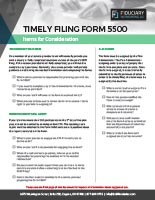
The Story
Landry’s Landscaping has a profit sharing plan that they created in 2006. They tasked Matt, the VP of HR and Benefits, to prepare the Form which he did for 2006 and 2007 filings. At the time the 2008 filing was due, Matt was no longer employed.
Melissa, who took Matt’s job, did not realize that Matt had been preparing the Form 5500s. Landry’s with learning a new job, she forgot to calendar a reminder to look for the Form 5500 for 2008.
Eventually Landry’s retained a new financial advisor who started a service provider review of the plan. During the review, it was realized the plan hadn’t file a Form 5500 since 2007. Somehow the IRS had failed to notice the missing filings.
How did they fix it?
Oblivious decided to hire a new service provider team. One member of that team, the non-fiduciary third party administrator, agreed to be responsible for preparing the e-signature ready Forms each year going forward.
Oblivious also retained the non-fiduciary third party administrator to prepare all of the missing filings and deliver them e-signature ready. Oblivious e-signed the forms and submitted them through the DFVC program. While they did pay to have the forms prepared, the DOL penalties totaled $1,500 for them. If they had been caught on audit without using the program, assuming penalties of $1,100 per day per form for each day a form is late, the penalties would have been astronomically higher.
How did they avoid it in the future?
Melissa realized that she did not have the expertise to know if all of the plan’s required government filings were being completed. Nor did she know all of the deadlines. After discussion with the management team, Melissa retained the services of Fiduciary Outsourcing to act as the responsible plan fiduciary for all government filings.

The Mistake
Each year the plan must file a Form 5500. The Form is due 7 months after the plan year ends. The due date can be extended by an additional 2½ months.
Forms 5500 must be e-filed using the Department of Labor’s EFAST2 system. As such, the filing date is easily ascertainable to both the Department of Labor and the Internal Revenue Service. So a failure to timely file is easily ascertained.
Recently the Department of Labor issued guidance that a Form 5500 filing for a large plan (i.e. one with more than 100 participants) that doesn’t include the independent CPA auditor’s report may be considered an incomplete filing.
Late and incomplete filings are subject to penalties. The penalties can be as high as $1,100 per day. Additionally, if the plan files for an extension but fails to file the Form by the extended due date, the penalty is retroactive to the original due date without extension.
Since the EFAST2 system is capable of electronically identifying late and incomplete filings, it is critical to file your plan’s Form 5500 on time.

What Happens
The Department of Labor has a correction program for filing late 5500 Forms. It’s called the Delinquent Filer Voluntary Compliance Program (“DFVC”).
You can read all about the program at: www.dol.gov
If you do discover that your plan has not filed a 5500 Form by the deadline, you should file the form as soon as possible. The penalties for failure to file a 5500 Form can go as high as $1,100 per day. For a small plan filer, the maximum cost of the DFVC program for a single late filing is $750 for a small plan (i.e. less than 100 participants) and $2,000 for a large plan (i.e. more than 100 participants). If you discover the error has occurred for multiple years, the maximum possible cost of the DFVC program is $1,500 for a small plan and $4,000 for a large plan. The DFVC costs are always going to be lower than the penalties assessed if you don’t file the forms, so get the forms done and file using the program.
You should be aware that the program used to electronically file the Forms will generate a reminder notice if you don’t file the 5500 Form timely. You can still use the DFVC program at this stage. Up until the time that a penalty assessment letter is sent out for a late or missing Form 5500, the DFVC program is the best correction option.
If you ignore the reminder letters and receive a penalty letter, you will likely be facing an audit shortly if the Form 5500 doesn’t get filed as soon as possible. So, please don’t ignore the reminder letters. Get your 5500 Form done and submitted using the DFVC program as soon as you are able.
Avoid it
Your service provider team will notify you when your 5500 Form is available to be e-signed. They may provide an authorization to allow them to sign on your behalf or they may provide a link where you can e-sign your own form. Either method of filing is acceptable.
You will want to set up a process to ensure you know the filing deadline for your plan. You’ll want to ensure you receive the notification on getting the form e-signed by following up with the appropriate service provider responsible for preparing the Form. Timely signing the Form is critical. It is easy to forget.
If your plan is audited, you’ll need to coordinate with your independent CPA auditors to get the audit report completed on time. Make sure you get your CPA auditors to start the audit as early as possible. Be clear with them on the deadlines. If you don’t want the plan’s filing to be put on extension, make that clear up front in the engagement.

How We Help
You have the ability to outsource your responsibilities as the Plan Administrator. As such, you can outsource the responsibility to oversee and e-sign your 5500 Form. We can track the due dates, coordinate with the other service providers to ensure the Form is completed on time, and notify you of any delays in getting the Forms timely signed. We can also provide you with confirmation that the Form was received by our office, e-signed, and filed.

The Story
Landry’s Landscaping has a profit sharing plan that they created in 2006. They tasked Matt, the VP of HR and Benefits, to prepare the Form which he did for 2006 and 2007 filings. At the time the 2008 filing was due, Matt was no longer employed.
Melissa, who took Matt’s job, did not realize that Matt had been preparing the Form 5500s. Landry’s with learning a new job, she forgot to calendar a reminder to look for the Form 5500 for 2008.
Eventually Landry’s retained a new financial advisor who started a service provider review of the plan. During the review, it was realized the plan hadn’t file a Form 5500 since 2007. Somehow the IRS had failed to notice the missing filings.
How did they fix it?
Oblivious decided to hire a new service provider team. One member of that team, the non-fiduciary third party administrator, agreed to be responsible for preparing the e-signature ready Forms each year going forward.
Oblivious also retained the non-fiduciary third party administrator to prepare all of the missing filings and deliver them e-signature ready. Oblivious e-signed the forms and submitted them through the DFVC program. While they did pay to have the forms prepared, the DOL penalties totaled $1,500 for them. If they had been caught on audit without using the program, assuming penalties of $1,100 per day per form for each day a form is late, the penalties would have been astronomically higher.
How did they avoid it in the future?
Melissa realized that she did not have the expertise to know if all of the plan’s required government filings were being completed. Nor did she know all of the deadlines. After discussion with the management team, Melissa retained the services of Fiduciary Outsourcing to act as the responsible plan fiduciary for all government filings.

The Mistake
Each year the plan must file a Form 5500. The Form is due 7 months after the plan year ends. The due date can be extended by an additional 2½ months.
Forms 5500 must be e-filed using the Department of Labor’s EFAST2 system. As such, the filing date is easily ascertainable to both the Department of Labor and the Internal Revenue Service. So a failure to timely file is easily ascertained.
Recently the Department of Labor issued guidance that a Form 5500 filing for a large plan (i.e. one with more than 100 participants) that doesn’t include the independent CPA auditor’s report may be considered an incomplete filing.
Late and incomplete filings are subject to penalties. The penalties can be as high as $1,100 per day. Additionally, if the plan files for an extension but fails to file the Form by the extended due date, the penalty is retroactive to the original due date without extension.
Since the EFAST2 system is capable of electronically identifying late and incomplete filings, it is critical to file your plan’s Form 5500 on time.

The Department of Labor has a correction program for filing late 5500 Forms. It’s called the Delinquent Filer Voluntary Compliance Program (“DFVC”).
You can read all about the program at: www.dol.gov
If you do discover that your plan has not filed a 5500 Form by the deadline, you should file the form as soon as possible. The penalties for failure to file a 5500 Form can go as high as $1,100 per day. For a small plan filer, the maximum cost of the DFVC program for a single late filing is $750 for a small plan (i.e. less than 100 participants) and $2,000 for a large plan (i.e. more than 100 participants). If you discover the error has occurred for multiple years, the maximum possible cost of the DFVC program is $1,500 for a small plan and $4,000 for a large plan. The DFVC costs are always going to be lower than the penalties assessed if you don’t file the forms, so get the forms done and file using the program.
You should be aware that the program used to electronically file the Forms will generate a reminder notice if you don’t file the 5500 Form timely. You can still use the DFVC program at this stage. Up until the time that a penalty assessment letter is sent out for a late or missing Form 5500, the DFVC program is the best correction option.
If you ignore the reminder letters and receive a penalty letter, you will likely be facing an audit shortly if the Form 5500 doesn’t get filed as soon as possible. So, please don’t ignore the reminder letters. Get your 5500 Form done and submitted using the DFVC program as soon as you are able.
Avoid it
Your service provider team will notify you when your 5500 Form is available to be e-signed. They may provide an authorization to allow them to sign on your behalf or they may provide a link where you can e-sign your own form. Either method of filing is acceptable.
You will want to set up a process to ensure you know the filing deadline for your plan. You’ll want to ensure you receive the notification on getting the form e-signed by following up with the appropriate service provider responsible for preparing the Form. Timely signing the Form is critical. It is easy to forget.
If your plan is audited, you’ll need to coordinate with your independent CPA auditors to get the audit report completed on time. Make sure you get your CPA auditors to start the audit as early as possible. Be clear with them on the deadlines. If you don’t want the plan’s filing to be put on extension, make that clear up front in the engagement.

How We Help
You have the ability to outsource your responsibilities as the Plan Administrator. As such, you can outsource the responsibility to oversee and e-sign your 5500 Form. We can track the due dates, coordinate with the other service providers to ensure the Form is completed on time, and notify you of any delays in getting the Forms timely signed. We can also provide you with confirmation that the Form was received by our office, e-signed, and filed.


